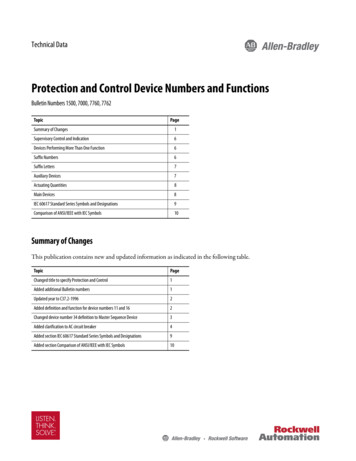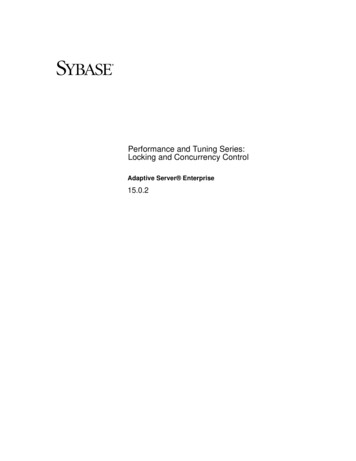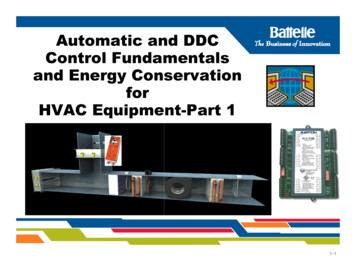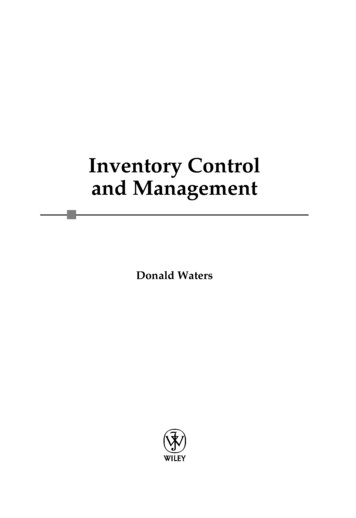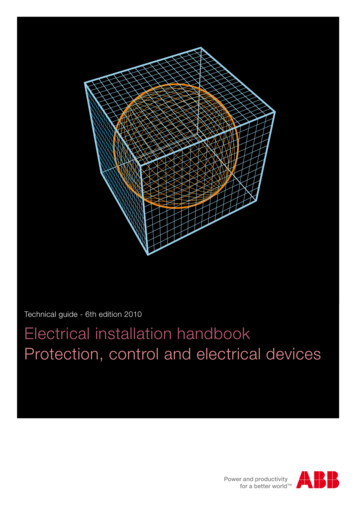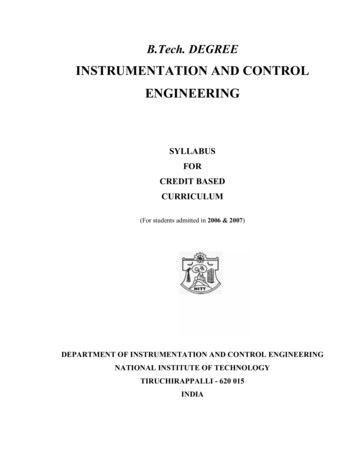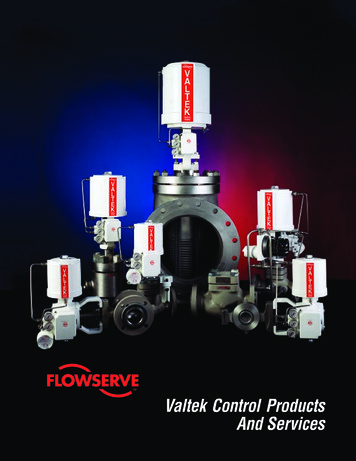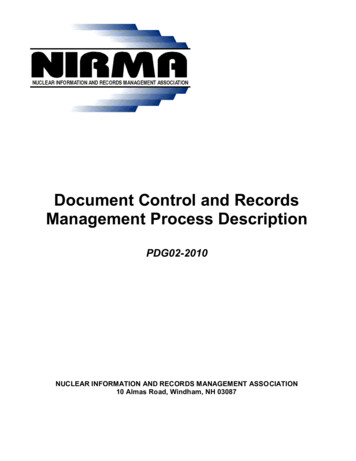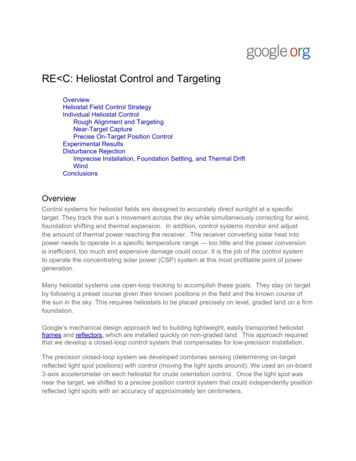
Transcription
RE C: Heliostat Control and TargetingOverviewHeliostat Field Control StrategyIndividual Heliostat ControlRough Alignment and TargetingNear-Target CapturePrecise On-Target Position ControlExperimental ResultsDisturbance RejectionImprecise Installation, Foundation Settling, and Thermal DriftWindConclusionsOverviewControl systems for heliostat fields are designed to accurately direct sunlight at a specifictarget. They track the sun’s movement across the sky while simultaneously correcting for wind,foundation shifting and thermal expansion. In addition, control systems monitor and adjustthe amount of thermal power reaching the receiver. The receiver converting solar heat intopower needs to operate in a specific temperature range — too little and the power conversionis inefficient, too much and expensive damage could occur. It is the job of the control systemto operate the concentrating solar power (CSP) system at this most profitable point of powergeneration.Many heliostat systems use open-loop tracking to accomplish these goals. They stay on targetby following a preset course given their known positions in the field and the known course ofthe sun in the sky. This requires heliostats to be placed precisely on level, graded land on a firmfoundation.Google’s mechanical design approach led to building lightweight, easily transported heliostatframes and reflectors, which are installed quickly on non-graded land. This approach requiredthat we develop a closed-loop control system that compensates for low-precision installation.The precision closed-loop system we developed combines sensing (determining on-targetreflected light spot positions) with control (moving the light spots around). We used an on-board3-axis accelerometer on each heliostat for crude orientation control. Once the light spot wasnear the target, we shifted to a precise position control system that could independently positionreflected light spots with an accuracy of approximately ten centimeters.
Heliostat Field Control StrategyFor any particular CSP system, the number of heliostats pointed at the receiver needs to beadjusted depending on the sun’s position in the sky. For example, at noon in the middle ofsummer fewer heliostats need to be pointed at the receiver than late in the afternoon on awinter’s day. A field management system decides which heliostats should be pointed at thereceiver and which should be held in reserve.In our prototype design, we assumed that a field strategy had already decided which heliostatsshould be on target. We thus focused on developing precision tracking for individual heliostats:aiming them at the target and allowing their solar energy distribution to illuminate the target ina prescribed manner to reduce stress and fatigue and provide optimum heat distribution in thereceiver.1Individual Heliostat ControlThe goal of our prototype system is to demonstrate simultaneous control of the light spots ofmultiple heliostats on a target. To accomplish this, we developed a closed-loop control systemin three parts:1. Rough orientation control of the heliostat using a reflector-mounted 3-axis accelerometerfor alignment within few degrees of accuracy.2. Capture of the heliostat’s light spot by a precise, target-mounted light spot positionsensor — in our case a multi-scopic photometry system.3. Precise, on-target position control using a multi-scopic photometry system to positionlight spots with an accuracy of 10 centimeters — sufficient to allow some control overheat distribution across a specific target such as a heat exchanger in a receiver.Rough Alignment and TargetingEach heliostat utilizes a solid-state 3-axis accelerometer mounted to its reflector to determineits rough orientation. The accelerometer measures mirror orientation with a precision of a fewdegrees of accuracy, enough to handle the following situations: Stowing at night or against inclement weather. Transitioning to morning startup orientation. Stationing off-target around noon. Rough aiming at the target, to allow capture by the precise light spot position sensingsystem.Our accelerometer data is made more useful using two unconventional features:1. Using pitch and roll articulation: Rather than using conventional azimuth-elevationcontrol, our heliostats use pitch (from flat to vertical) and roll (about the pitch axis) as theaxes of articulation. This allows the accelerometer to resolve orientation in both axes ofmotion.2. Off-vertical angle offset: The closer the articulated roll axis of the heliostat is to thevertical, the less accurately the 3-axis accelerometer can resolve roll. Mounting themirror off-vertical from the articulation allows the mirror to be vertical while the roll axis isnot — yielding adequate roll resolution throughout commonly used pitch orientations.1For more information on the receiver used, see the RE C: Brayton Project Overview.
A command to move the heliostat can either be a desired mirror orientation, or a desired lightorientation using a reflection equation. Once the command is sent, the heliostat controllerrepeats these steps:1. Retrieving a desired reflector orientation.2. Determining the approximate current reflector mirror orientation using accelerometerdata.3. Computing the reflector movement path in response to the difference between thedesired reflector orientation and measured reflector orientation.4. Mapping the reflector movement into desired actuator rates.5. Transmitting the actuator rates to the cable actuators.Near-Target CaptureWhen a heliostat’s reflected light spot is pointed towards the target, control of the heliostat musttransition from rough aiming using accelerometer data to precise, on-target position control.There are two important components of this transition: capture strategy and capture detection.Capture strategy is lining up the heliostat angle with the target so the on-target position controlcan sense it and “capture” it. The heliostat accelerometer has an accuracy of a degree, whilethe on-target position control has a tighter resolution of 1/200 of a radian (about 0.25 degrees).Because of these differences, it’s possible that the heliostat could think it’s pointed directly atthe target, while the target is unable see it. In our testing, the accuracy of the accelerometerwas sufficient most of the time. If it misses, the heliostat could move in a spiral pattern — tight,widening circles — until the light spot is captured.Capture detection happens when the on-target positioning system detects the location of alight spot from a specific heliostat in its field of view. At this point, the heliostat’s control systemswitches from relying solely on the accelerometer to relying on the on-target spot positionsensing system, which has far higher precision and accuracy.Precise On-Target Position ControlThe goal of precise targeting is to position the reflected light spots within 10 centimeters of theiroptimal location on a target. This resolution — the equivalent of a milliradian or better as seenfrom the further heliostat reflectors at 100m away — is far beyond the accuracy and resolutionof our reflector mounted accelerometer. Since our heliostats are relatively small, it made sensefrom a cost standpoint to build a central target light spot position sensing system.We extended the light spot sensing algorithms described by Kribus et al. in their 2004 paperto provide on-target (x,y) location information for each light spot reflected off a heliostat, andto detect if a light spot was within the greater target area. We built a multi-scopic photometrysystem, using multiple cameras situated around the target to triangulate and direct incominglight. For each light spot on the target, the system reports an x,y coordinate on a target plane,and if the heliostat is in the system’s range of detection.The high-performance receivers that absorb the heat for CSP power conversion require carefultemperature management. Precise distribution of solar flux reflected off the heliostats isrequired to optimize power generation. This is why we need to carefully measure and position
light spots on target.The test target with mounted cameras. Although this target has 8 cameras, only 4 were used at a time.A heliostat starts with a light spot already on or near the target. Given a strategy for determiningwhere we want that light spot to be, our controller moves the heliostat, moving the spot directlyto the desired location. The control loop in our precision light spot positioning program performsthe following steps:1. Determines the desired light spot position.2. Uses the precision sensing system (cameras mounted on the target) to estimate the lightspot’s position.3. Determines the heliostat’s reflector orientation using its mounted accelerometer.4. Using a control law, maps the difference between the light spot’s actual position andits desired position on the target plane, into a desired spot speed and direction onthe target, then maps that into a desired angular velocity for the heliostat, and finallytranslates that information into heliostat cable actuator speeds.5. Communicates the desired actuator speeds to the actuators.Experimental ResultsThe experimental setup consisted of a collection of heliostats and a vertical target surfacesurrounded by four cameras. The prototype used a 1m x 1m mirror and could accurately placea light spot 36 meters away (about the full length of the roof we were doing testing on). Theshape of the reflection in the image below is in part due to the distortions of the mirror used.
Prototype Heliostat Keeping Light on TargetOur prototype heliostat oriented towards the sun in the morning and tracked the sun throughoutthe day. The following video shows control of a heliostat over a 12-hour period, replete withwind, clouds, sunrise and sunset.Video: Time Lapse of heliostat operationThe control software we developed for the prototype was written in C . Matlab code that usesa similar control algorithm was also developed for simulation. The Matlab code simulates thecontrol of a field of heliostats, using simulated position error sensing and 3-axis accelerometersensing. We’ve published the Matlab code as open source code available for download.
To measure our accuracy, we plotted the location of the light spot placed by the tracking systemfor one heliostat under clear skies. From our plot, 96% of the observations falls within a 5 cmradius, 88% within 2 cm.2Targeting System AccuracyWe added two more heliostats to the control system to prove that we could control severalheliostats simultaneously. Video recordings show the light spots of three heliostats beingsimultaneously controlled in three separate but coordinated paths. Since the actuators aredesigned to only move the heliostat slowly: the video is sped-up in time by a factor of 5 somotion is obvious.2The horizontal plane represents the target, and the Z-axis represents the number of times the positioning systemreported the center of the reflection to be within a centimeter of the target.
Video: Demonstrating single and multiple heliostat controlDisturbance RejectionMany factors can contribute to light spot inaccuracy. We thus developed procedures to addresserrors resulting from imprecise installation, foundation settling, thermal drift, and wind.Imprecise Installation, Foundation Settling, and Thermal DriftThe cumulative error introduced by these factors can add up to several degrees of orientationerror. All of these contribute to errors during rough pointing, and if significant enough, couldmake light spot capture for precise, on-target positioning difficult. These factors only introducedproblems when we had grossly miscalculated the location of the heliostat relative to the target,or when it was misoriented by more than a few degrees. A one-time calibration after installationaddressed these issues, and this calibration process could be fully automated in a productionsetting.During precise on-target positioning, these sources of error do not affect the positioning ofthe heliostat due to the closed-loop nature of the control system. We tested this by tiltingand moving heliostats as they were actively tracking. The precise pointing control systemautomatically compensated for these disturbances and realigned the light spot with the target.WindWind is a slightly trickier technical challenge. Wind can move and shake the reflector, causingthe light to go off-target. The reflector element is stiff enough to not deform significantly inthe wind. However, our choice to go with a lighter-weight heliostat frame led to the heliostat’sstructure and actuator flexing in response to large wind loads.When examined in the frequency domain, orientation changes of the reflector due to wind canclassified into three frequency bands, each with its own characteristics:
Frequency BandExampleCompensationLow-frequency:(less than 1 cycle/minute)Steady wind from afixed direction.Feedback control system compensates directly for steadywind-induced spot position error.Mid-frequency:(1/10 to 10 cycles/second)Wind gusts, shifts inwind direction., andvortex sheddingReflector motion could be dampened using passive viscousdamping devices such as dashpots.High-frequency:(more than 10 cycles/second)Turbulence and windmixing.The mass and inertia of the heliostat reflector dampenswind induced oscillation increasingly effectively with higherfrequency.Using a control system running at 1 sample per second, we addressed the ultra-low and lowfrequency wind disturbances. A discussion of the mid-frequency and high-frequency windeffects is covered in the heliostat wind mitigation document.ConclusionsBy adopting a closed-loop control system that combined rough orientation sensing using 3-axisaccelerometers with precision camera-based light spot position sensing technology, we wereable to create a controller that achieved the following design goals: Orienting the mirror in the morning to be ready for sun-up. Roughly placing the light spot close enough to the target to be “captured” by theprecision control system. Keeping the light spot positioned precisely throughout the day. Keeping a light spot positioned precisely when (manually) tilting the frame of theheliostat by several degrees. Independently positioning the light spots from three heliostats simultaneously on target. Redressing some of the potential errors from imprecise installation, foundation settling,thermal drift and wind disturbance.We continue to believe that the cost savings of moving away from strong structural membersand precision heliostat installation significantly outweighs the cost of the sensors and controlsystem software, since computation continues to become cheaper every year, unlike rawmaterials.
The receiver converting solar heat into power needs to operate in a specific temperature range — too little and the power conversion is inefficient, too much and expensive damage could occur. It is the job of the control system . Uses the
